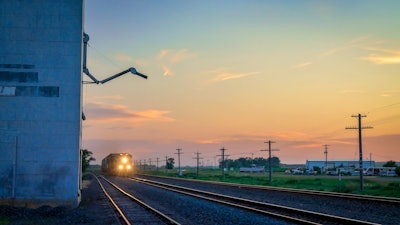
There is a battle brewing between railroads and their customers about how easy it should be to challenge the rates charged by railroads.
The Biden administration has asked the Surface Transportation Board (STB) to consider a rule on competitive switching initially proposed in 2016. The administration also asked the STB to look into other rulemaking for relevant matters of competitive rail access, including bottleneck rates and interchange commitments.
The request for the STB to look into and eventually propose new rules has divided agriculture and other small shippers from the railroads.
Small shippers favor more options when choosing their cargo railroads and would like an easier way to challenge rail rates.
The railroads would like to keep things the same or make small changes. They argue that the regional monopolies and industry consolidation allow them to compete with other shipping forms, including trucks and barges.
The railroads also claim rail prices have been reasonable over the past decade, instances of railroads abusing their power are rare, and regulation increases costs and overall prices.
The STB has yet to create any rules, but it has been taking public comments about what rules should be made.
The National Grain and Feed Association (NGFA) and industry partners at the Agricultural Transportation Working Group (ATWG) have sent comments to the STB encouraging them to implement rules that will help level the playing field when doing business with the railroads.
Passed in 1980, the Staggers Rail Act deregulated railroads and is directly responsible for how rail disputes are handled today.
The law made the following changes:
- Rail carriers can establish any rate for a rail service unless there is no effective competition
- Rail shippers and carriers are allowed to establish contracts without review, as long as the contract service would not interfere with the rail carrier's ability to provide standard carrier service
- STB’s authority to control rates to prevent discrimination was curtailed
- Industry-wide rail rate increases were eliminated
- Collective rate-making machinery among railroads was dismantled
For 40 years, the Staggers Rail Act has guided the STB on regulating railways. Railroad carriers have been quick to point to how successful the law has been at reducing the costs of rail service and allowing railway carriers to spend billions of dollars repairing and expanding their networks.
On the other hand, advocates for change have argued the rail industry's consolidation has led to fewer options for small shippers, giving the rail carriers the advantage in business negotiations.
Finally, the way disputes are challenged under the Staggers Rail Act is an expensive process that can take years to settle, making it an undue burden on shippers.
Competitive switching
At the time of this writing, the STB has yet to hold the first hearing on competitive switching, also known as Reciprocal Switching.
The first hearings will be held on March 15-16, 2022, and will focus on the proposed reciprocal switching regulations in Reciprocal Switching, Docket No. EP 711 (Sub-No. 1) et al. (NPRM). Read NGFA's comments from the hearings here.
The NPRM introduces new regulations under which the board would exercise its statutory authority to require rail carriers to establish switching arrangements in certain circumstances.
The NPRM generated divergent responses from various stakeholders, and the board has reviewed the existing record in this proceeding.
Since issuing the NPRM and receiving written comments, there have been significant changes in and affecting the freight rail industry.
In a letter signed by 27 ATWG members and sent to the STB by ATWG and NGFA, an ATWG member explained why adopting new rules is essential to agriculture rail shippers:
“We believe that enhanced competition is an important vehicle through which the board can address pervasive challenges faced by rail shippers, including poor rail service and unreasonable rail rates and practices,” noted the member.
The letter also claimed that over the past 40 years, railroad mergers have shrunk the number of Class I railroads from 33 to seven, and two major duopolies have formed in the eastern and western halves of the U.S.
“While these mergers succeeded in rationalizing rail capacity, they increased railroad market power such that many shippers no longer have access to competition necessary to promote efficient service, reasonable rates and charges, and fair practices,” noted the letter.
The railroads argue implementing competitive switching is unnecessary and will be challenging and costly to implement, driving up prices for all rail freight users.
Do not expect a rule for competitive switching to happen soon. Even if the rule is adopted and written by the STB quickly, a challenge in court is likely.
Final Offer Rate Review
The second rule being looked at by the STB at the administration's request is the Final Offer Rate Review (FORR) process for small shippers.
If the STB adopts FORR, it will be quicker, easier and less costly to challenge rail rates for small shippers.
The STB has already gone through most of the rule-making process for FORR, with the rule written and ready for adoption.
FORR is being held up until the STB decides on a separate proposal to establish a voluntary “Small Case Arbitration Program” to exist alongside the board’s current voluntary arbitration program.
Some in the railroad industry support the Small Case Arbitration Program as a compromise. The rule will allow small rail shippers to have their complaints judged by and ruled on by an arbitrator with the ruling results sealed to the public.
The NGFA is not opposed to the Small Case Arbitration Program. It even submitted the following suggestions when the STB asked for comment on the proposed rule.
FORR exemptions: As the arbitration program proposal is currently written, Class I railroads may be granted a waiver from FORR for five years or more without adequate evaluation.“This is not acceptable to NGFA’s members,” NGFA noted in its comments, suggesting an initial two- or three-year term for the exemption coupled with an evaluation.
Transparency: NGFA recommended the final rules contain a requirement that arbitration decisions under the program should include publication on the board’s website with case details, including names of the parties involved, the rationale used by arbitrators in reaching their decision and the award. “Each of these public features enhances accountability and integrity of the process,” NGFA noted.
Rail service data: “The reason that some NGFA members do not pursue formal rate relief or otherwise challenge rail rates before this board is that they fear retaliation by their serving railroad, on which they are entirely dependent for rail service,” NGFA noted.
The NGFA urged STB to incorporate the rail service data it collects from the Class I railroads into the Small Case Arbitration Program to encourage participation.
The NGFA hopes the STB will pass both rules, with FORR as a backup if the Small Case Arbitration Program fails to change the rate challenging process.
Ultimately the choice is in the hands of the STB. If these rules pass, however, grain and agriculture shippers may once again have leverage against the railroads for the first time in 40 years. ■
.jpg?auto=format%2Ccompress&crop=faces&fit=crop&h=48&q=70&w=48)


















